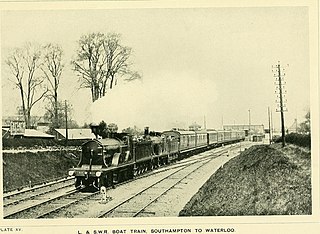
The London and South Western Railway was a railway company in England from 1838 to 1922. Originating as the London and Southampton Railway, its network extended to Dorchester and Weymouth, to Salisbury, Exeter and Plymouth, and to Padstow, Ilfracombe and Bude. It developed a network of routes in Hampshire, Surrey and Berkshire, including Portsmouth and Reading.
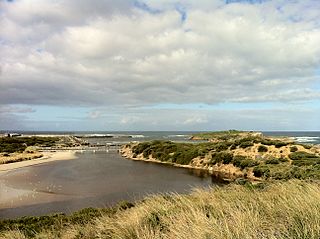
Warrnambool is a city on the south-western coast of Victoria, Australia. At the 2021 census, Warrnambool had a population of 35,743. Situated on the Princes Highway, Warrnambool (Allansford) marks the western end of the Great Ocean Road and the southern end of the Hopkins Highway.

Port Fairy is a coastal town in south-western Victoria, Australia. It lies on the Princes Highway in the Shire of Moyne, 28 kilometres (17 mi) west of Warrnambool and 290 kilometres (180 mi) west of Melbourne, at the point where the Moyne River enters the Southern Ocean.

Koroit is a small rural town in western Victoria, Australia a few kilometres north of the Princes Highway, 18 kilometres (11 mi) north-west of Warrnambool and 272 kilometres (169 mi) west of Melbourne. It is in the Shire of Moyne local government area located amidst rolling green pastures on the north rim of Tower Hill. At the 2016 census, Koroit had a population of 2,055. The town borrows its name from the Koroitch Gundidj people who occupied the area prior to European colonisation.
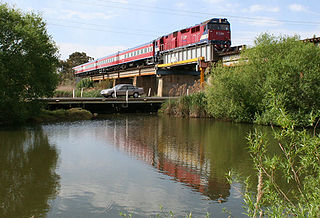
The Warrnambool line is a long-distance regional rail service in Victoria, Australia. Operated by V/Line, it is the state's fourth longest railway line at 267.3 kilometres (166.1 mi). The line runs from Southern Cross station in central Melbourne to Warrnambool station in the south-east, serving 21 stations via Wyndham Vale, Geelong, Waurn Ponds, and Colac. The line has five return services each weekday and three return services on weekends. Trains on the Warrnambool service run with three- to five-car N-class carriage sets, which are hauled by N class locomotives.

The Melbourne cable tramway system was a cable car public transport system, which operated between 1885 and 1940 in Melbourne, Victoria, Australia.
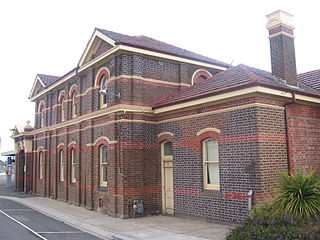
Warrnambool railway station is the terminus of the Warrnambool line in Victoria, Australia. It serves the city of Warrnambool, and it opened on 4 February 1890.

A street running train is a train which runs on a track built on public streets. The rails are embedded in the roadway, and the train shares the street with other users, such as pedestrians, cars and cyclists, thus often being referred to as running in mixed traffic or sharing the road with trains. For safety, street running trains travel more slowly than trains on dedicated rights-of-way. Needing to share the right-of-way with motor vehicles can cause delays and pose a safety risk.

The Portland Branch railway refers to a group of lines on the Isle of Portland in the English county of Dorset. The first was the Portland Railway, in fact a tramway with a counterbalanced rope worked incline. It opened in 1826. It was followed by the Weymouth and Portland Railway, which connected to the main line of the Great Western Railway at Weymouth. It opened in 1865. From the late 1840s until 1872 Portland Breakwater was built, a prodigious construction task that created a very large safe harbour. It was decided to provide a railway connection to the breakwater, which was used as a pier for bunkering ships. This was constructed by the LSWR and the GWR jointly, and opened in 1876. The fourth line was the Easton and Church Hope Railway. This line was conceived as a simple descent to bring stone down from quarries to a new jetty at Church Hope, but after their line was authorised in 1867, the Company delayed useful construction, and a change of plan followed, with several Acts of Parliament authorising modifications to the route and extension of time. It finally opened in 1900.

The Port Fairy railway line is a railway serving the south west of Victoria, Australia. Running from the western Melbourne suburb of Newport through the cities of Geelong and Warrnambool, the line once terminated at the coastal town of Port Fairy before being truncated to Dennington. This closed section of line has been converted into the 37 km long Port Fairy to Warrnambool Rail Trail. The line continues to see both passenger and freight services today.
The Portland railway line is a railway line in south-western Victoria, Australia. It runs from the main Western standard gauge line at Maroona through Hamilton to the port town of Portland.

The Port Fairy - Warrnambool Rail Trail is a 37 kilometre rail trail in southwestern Victoria, Australia. The official opening of the trail took place on 31 May 2012 at the Koroit Railway station building.

Hamilton is a railway station located on the Ararat - Portland railway in the city of Hamilton, Victoria, Australia. Today the station is now used only for through trains, and the large station building is used only to serve bus passengers, although the disused platform remains in reasonable condition.
The Mortlake line is a closed railway line in the west of Victoria, Australia. Branching off of the main Port Fairy railway line at Terang, then running North to the small town of Mortlake, Victoria.
The Hamilton Spectator is a tri-weekly tabloid newspaper, which has been published in Hamilton, Victoria, Australia since 1859. It is published by the Hamilton Spectator Partnership Pty Ltd. Originally, the Spectator was known as the Hamilton Courier as established in 1859 by Thomas Wotton Shevill, it then became the Hamilton Spectator and Grange District Advertiser in 1860, and later The Hamilton Spectator.
The Katamatite railway line is a disused railway located in northern Victoria, Australia. It was built as a tramway, running from Dookie to Katamatite, and opened on 11 August 1890. Two years later it was taken over by the Victorian Railways (VR) and sections of the track were upgraded allowing its reclassification as a railway. The line was formally closed on 13 January 1987.
The Casterton Line was a branch line running north-west from the Portland Main Line, from the town of Branxholme to the town of Casterton, in Victoria, Australia. Opening in 1884, the line was 51 kilometres (32 mi) long and completely single track, apart from at stations.
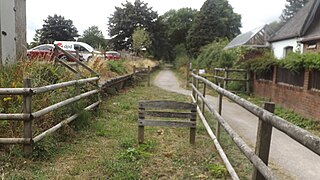
The Biddulph Valley line was a double tracked line that ran from Stoke-on-Trent to Brunswick Wharf in Congleton. The line was named after the town of the same name as it ran via the Staffordshire Moorlands and covered areas of East Staffordshire and Cheshire.

The Lake Erie and Northern Railway was an interurban electric railway which operated in the Grand River Valley in Ontario, Canada. The railway owned and operated a north–south mainline which ran from Galt in the north to Port Dover on the shore of Lake Erie in the south. Along the way, it ran through rural areas of Waterloo County, Brant County, and Norfolk County, as well as the city of Brantford, where it had an interchange with the Brantford and Hamilton Electric Railway. Construction on the mainline began in 1913. The railway began operations in 1916 as a subsidiary of the Canadian Pacific Railway (CPR), which had purchased the line before construction had finished. In 1931, it was consolidated with the Grand River Railway under a single CPR subsidiary, the Canadian Pacific Electric Lines (CPEL), which managed both interurban railways, though they continued to exist as legally separate entities. Passenger service was discontinued in 1955 but electric freight operations continued until 1961, when the LE&N's electric locomotives were replaced by diesel CPR locomotives and the line was de-electrified. In the same year, service on the mainline from Simcoe to Port Dover was discontinued, but the remainder continued to operate as a branchline which as early as 1975 was known as the CP Simcoe Subdivision. The remainder of the line was officially abandoned in the early 1990s, ending almost seventy-five years of operation.













